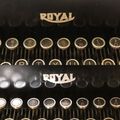Typewriter Cleaning and Cleanliness
Contents
Overview
Cleaning a dirty typewriter and keeping a clean typewriter are essential to putting machines into good condition and keeping them there. This guide will go over cleaning a newly found/bought typewriter, and tips to keep your currently cleaned typewriter clean.
!WARNING!
USE EXTREME CAUTION AROUND DECALS. Usually it is best to not clean these and leave them alone. You might try dusting them off gently. But NEVER touch these with ANY kind of solvent or degreaser. Decals are replaceable, but you can't replace an original. Most paint is also very sensitive to degreasers and solvents as well, so USE CAUTION. If you absolutely have to use a degreaser or solvent, always test it in a inconspicuous corner of the typewriter. Use these chemicals as a last resort.
Deep Cleaning and Touching Up
Your typewriter will most likely have been collecting dust, dirt, and other grime for 40 years or more. Take these steps to give it a good deep clean.
Blowing Out
The first step usually taken is to blow the typewriter out to get all sorts of loose dust and other particles out of the machine. Use canned air or an air compressor (the latter is recommended) to gently blow in and around the machine. This is best done outside, and with the panels off of the machine to allow for the maximum reach inside the machine. A small detailing brush paired with a vacuum cleaner will work wonders.
Dusting without compressed air
An air compressor can send piece of your typewriter flying if they're not secure, so some prefer a low powered vacuum with a dust cup with filter. There are ones for cleaning electronics/keyboards that can serve this purpose. Others used canned air or low pressure compressors.
A detailing brush with a small handheld vacuum like the one described above can be effective at removing hair and other debris. Other tools one might use are a dental pick, a paint brush, and pipe/straw cleaners (single use or reusable, hard and soft). Using tools can be more effective than canned air at times.
Cleaning Paint, Stains, and Patches of Dirt
Paint is best cleaned by spraying WD-40 onto a rag and wiping down the typewriter. Be VERY gentle around decals (try to avoid them) and DON'T get any WD-40 inside the machine. It reacts very badly with dirt and gums up very easily and is hard to get out. Patches of dirt can be rubbed off with a damp rag or paper towel.
Cleaning Crinkle Paint
Clean with WD-40 and a toothbrush. Per usual, make sure to keep WD-40 stays away from the innards. Exclusively apply it to the panels Avoid any decals and painted lettering/details. Wipe off with a dry rag to absorb it. WD-40 is hydrophobic so if you use a wet rag it won’t soak up.
White Residue on 50's plastic keys
White powder on 1950s and later plastic keys is a result of a chemical process known as degassing and a result of decomposition in the plastic itself. It can be removed with vigorous dry rubbing, with bare fingers or gently with a Scotch Brite pad. Some say that WD-40 on your fingers may help. Do a couple now, do something else, do a couple more. You might get blisters. Have fun!
Removing Rust
Rust can be removed with either a rust remover solution or a brass brush. I recommend Evaporust for rust remover. You'll want to take the part/assembly completely apart first, and soak it until it's not rusty anymore. Brass brushes are good for brushing off rust in patches or mechanisms you don't want to take apart.
Touching Up Paint
Little paint touch-up spots can be fixed with modeling paint (usually gloss black) and a small detailing paintbrush. For small small spots, a Sharpie even works.
Keeping your Typewriter Clean and Healthy
After you've given your machine a deep clean, you'll probably want it to stay that way. Dust can be prevented by:
- Keeping your machine covered with a dust cover or in it's case
- Storing it in a clean environment
- Blowing it out every once in awhile to prevent a build up of dust
- Check your manual for oiling advice. It's best to oil carriage rails and the escapement (if you can reach it) always, and a manual will pinpoint specific oiling points.

